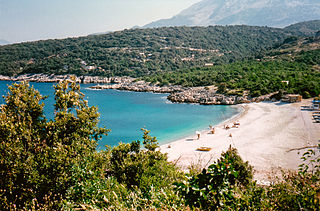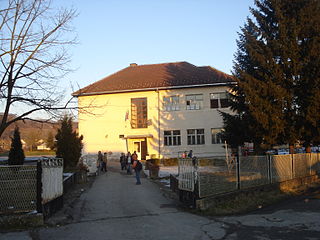
Mladenovac is a municipality of the city of Belgrade. According to the 2022 census results, the municipality has a population of 48,683 inhabitants, while the urban area has 22,346 inhabitants.

Velika Drenova is a village of about 5,000 inhabitants in Trstenik municipality, Rasina District, Serbia. It is located on the Zapadna Morava River in the central Serbian area of Šumadija. Velika Drenova is the biggest producer of vine in Serbia and vinegrapes are a major export. Velika Drenova is also known by its grafters which is heard about all over the world. One of the biggest producer of vine is First Grafters Cooperative 1903.

Kelmendi is a historical Albanian tribe (fis) and region in Malësia and eastern Montenegro. It is located in the upper valley of the Cem river and its tributaries in the Accursed Mountains range of the Dinaric Alps. The Vermosh river springs in the village of the same name, which is Albania's northernmost village. Vermosh pours into Lake Plav.

Begaljica ) is a rural settlement in the Grocka municipality of eastern Belgrade, Serbia. It is one of 15 settlements of Grocka, situated in its centre, with a population of 8,233 according to the 2011 preliminary census. The village is located at the water source of the Begaljica river, a tributary of the Danube, thus in the southern half of Podunavlje, as well as in the fertile Šumadija region of central Serbia.

Mrkojevići is a historical tribal region in southwestern Montenegro, located between the towns of Bar and Ulcinj. The region borders Krajina to the east. The Mrkojevići form a distinct ethno-geographical group with their own dialect of the Serbo-Croatian language, while also exhibiting a degree of bilingualism in Albanian. Their customs are distinct from their neighbouring Slavic and Albanian communities, but they also show influence and contacts with them. In the 400-year Ottoman period, the Mrkojevići converted to Islam, which forms an important aspect of their cultural identity.

Dublje is a village in Serbia. It is located in the Svilajnac municipality, in the Pomoravlje District. According to 2002 census, its population numbers 1,050 people. There is a book about Dublje.

Hoti is a historical Albanian tribe (fis) and sub-region of Malësia, a divided area located in northern Albania and southern Montenegro. Its geography is mostly mountainous, but some of its villages are on flat terrain near the banks of Lake of Shkodër.

Čučer-Sandevo is a village in Republic of North Macedonia. It is a seat of the Čučer-Sandevo Municipality.

Čečava is a village in the municipality of Teslić, Bosnia and Herzegovina. Čečava is one of the largest Serb villages in the municipality.

Shkreli is a historical Albanian tribe and region in the Malësia Madhe region of northern Albania and is majority Catholic. With the expansion of the Ottoman Empire, part of the tribe migrated to Rugova in Western Kosovo beginning around 1700, after which they continued to migrate into the Lower Pešter and Sandžak regions.

Donja Borina is a village in Serbia. It is situated in the Mali Zvornik municipality, in the Mačva District of Central Serbia. The village has a Serb ethnic majority and its population was 1,731 in 2002.

Baljci, also referred to as Baljke, is a village in the Dalmatian Hinterland, southeast of Knin in the Šibenik-Knin County. The settlement is administered as a part of the Ružić municipality.

The Orlović are a noble house originating in medieval Serbia.
Zalužnica is a village in the Gacka valley in present-day Lika-Senj County, Croatia. It is located around the road between the market town of Otočac and the Plitvice Lakes National Park. It was likely mainly populated in the early to mid-17th century. The existing village church dates from 1753 and anecdotal evidence suggests it was preceded by an earlier wooden built church. A peak population was reached in the late 19th century and from there progressively reduced due to migration and war. It was almost totally de-populated in 1995 during the war that saw the breakup of the former Yugoslavia when the high majority of the population left for Serbia. A handful of old people remained in the village unable or unwilling to make the long trek. A few new people subsequently established holiday homes over the last 10 years and a few returned from Serbia. More recently, local authorities have given Roma people use of the many empty farm properties. The annual Petrovdan celebrations were re-established in the 2000s attracting people with a connection to the village from Serbia and from abroad.
Rašica (Albanian: Rashica) is a village in the municipality of Blace, Serbia. According to the 2002 census, the village has a population of 183 people.
Donja Bela Reka is a village in the municipality of Bor, Serbia. According to the 2022 census, the village has a population of 633 people.
Crna Glava is a village in the municipality of Raška, Serbia. As of the 2002 census, the village has a population of 246 people. Crna Glava is one of the oldest places in Serbia and is mentioned in Žiča in "hrisovulja" from 1222.A.C. as "Čisto brdo" which is a part of today's village.
Drlupa is a village in the municipality of Sopot, Serbia. According to the 2002 census, the village has a population of 547 people.

Kičinica is a village in the municipality of Mavrovo and Rostuša, North Macedonia.













